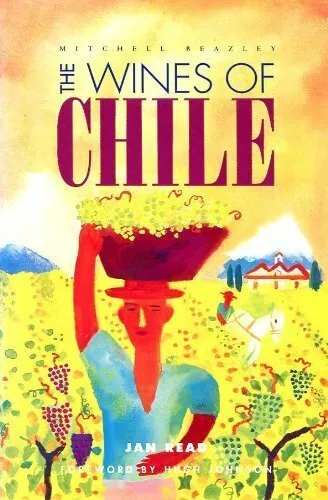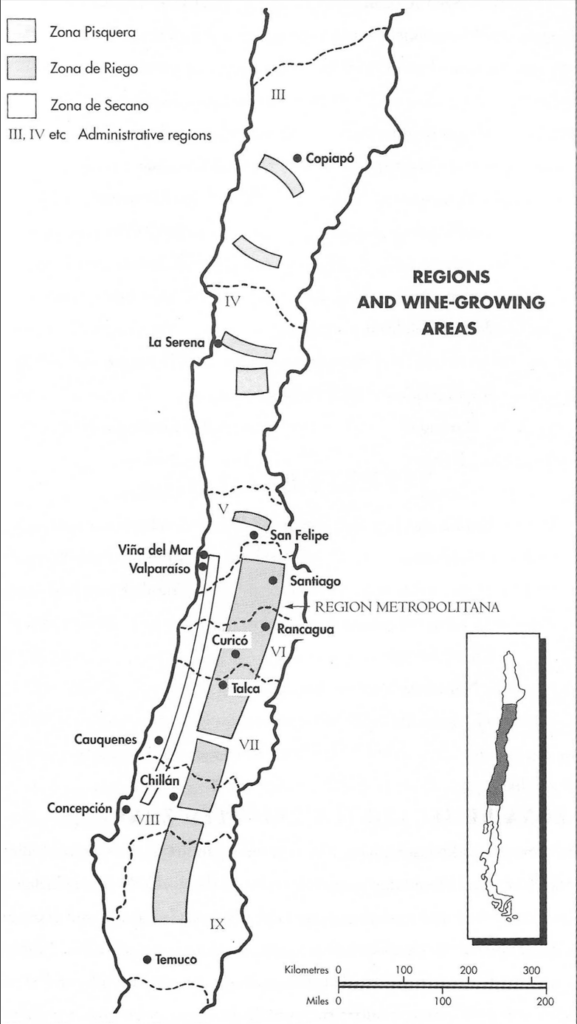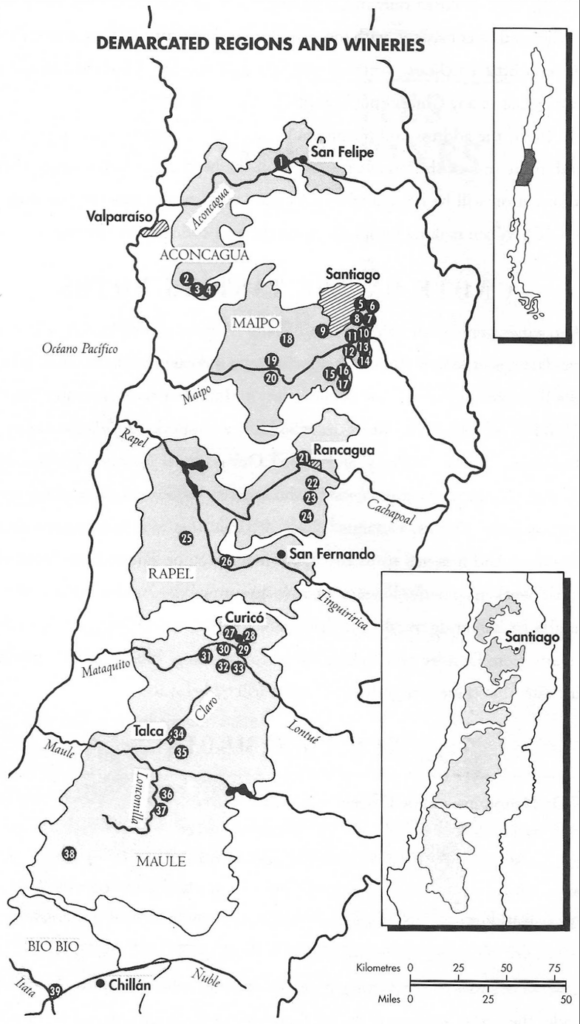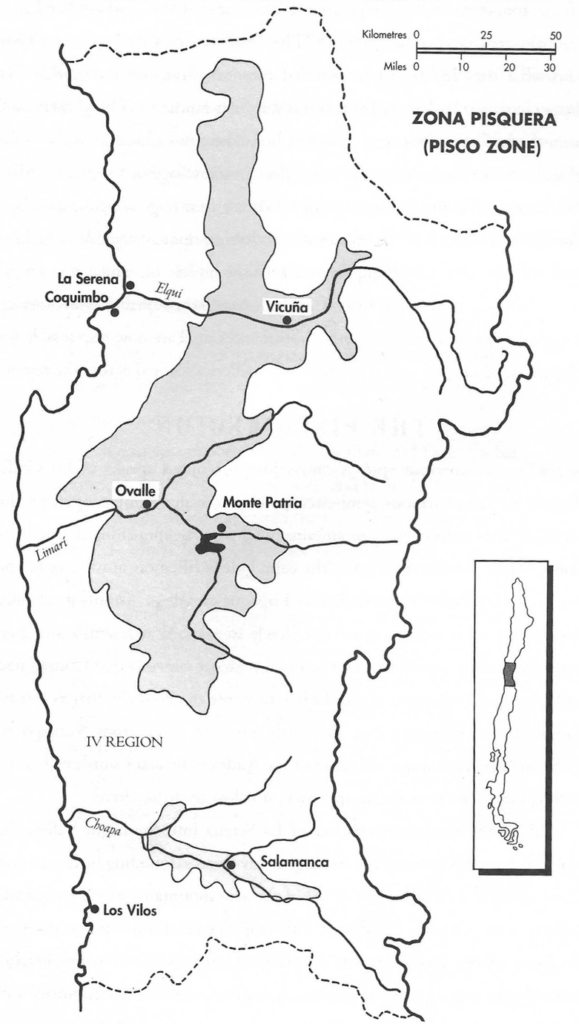
| Title | The Wines of Chile |
| Author | Jan Read |
| Publisher | Mitchell Beazley (Reed International) |
| Date | 1994 |
| ISBN | 978-1857323306 (Hardcover) |
| Pages | 184 |
| Summary | Contains information on the history, wines, vineyards, producers and food of Chile, where a new generation of wine-makers trained in France are making the most of the vast Chilean grape-harvest to produce world-class wines which are now finding their way into the UK. |
| Shop | The Wines of Chile (WorldCat) / BookFinder.com |
Interesting account of the state of the wine industry in Chile in the early 90s when the export started to take off, only one winery used a mechanical harvester (Concha y Toro), trains were still running, and Casablanca was considered a promissing new region.
Jan Read (1917-2012)
Jan Read was a scientist, a film and television writer and a wine expert.
- Jan Read, Scientist and Film Writer, The Herald Scotland (2012
From his last book, Young Man in Movieland, About the author:
Jan Read has written or co-written such motion pictures as The Blue Lamp and Jason and the Argonauts. After spending many years in the motion picture and television industries, he has authored a great number of books on wine, travel, and gastronomy. He is a regular contributor to Decanter and other leading British, American, and Spanish wine magazines.
- Jan Read 1917-2012 by Carlos Read, jancisrobinson.com (2012)
Goodreads lists 30 distinct works (including some translations). For wine, Read has written about Spain, Portugal, and Chile.

His first book on the topic was published in 1988: Chilean Wines; with an introduction and tasting notes by Hugh Johnson (978-0856673436).
From Johnson’s autobiography, The Lifes and Wines of Hugh Johnson (Académie du Vin Library, 2022):
I went back to Chile in 1984 with friends who had been my interpreters and guides many times in Spain, Jan and Maite Read, to help them with the first English book on Chilean wine.
From the Foreword of The Wines of Chile (1994)
Jan and I (..) visited Chile together 10 years ago. (…)
It is only right that the writer and oenologist who more than anyone spurred it on should report and celebrate Chile’s emergence as one of the world’s great wine-lands, ready for the 21st century. Jan Read, long steeped in history, science and culture of wine in the Spanish world, is uniquely able to put this great new resource into perspective for us.
About the Book
Wines of Chile starts with a short introduction about the country (as you would find in a travel guide), about the wine making tradition, and an anatomy (region and varieties). Most of book covers the wineries and their wines (see below). The book ends with chapters about Pisco and Chilean food (by Maite Read), and includes some recipes.
Wine Making Tradition
This chapter covers the history starting with the Spanish conquista, from the first vineyards, until Chile was a mayor exporter of wines to the other Spanish domains in South America, mostly from país and mostly from what is now the Itata region. After independence, trade with the outside world greatly increased (US and UK), mainly minerals but also agricultural produce (including wine). French varieties are introduced (and French oenologists), just before phylloxera, facilitated by a direct Liverpool-Valparaiso steamboat service (1868). Amongst its passengers
- Cristian Lanz (Viña Carmen 1850)
- Louis Cousiño (Viña Cousiño Macul 1856)
- Macario Ossa (Viña Santa Teresa 1860)
- Gregorio Correa Albano (Viña San Pedro 1865)
- Luis Perreira (Viña Santa Carolina 1875)
- Domingo Fernández Concha (Viña Santa Rita 1880)
- Melchior Concha y Toro (Viña Concha y Toro 1883)
- Francisco Undurraga (Viña Undurraga 1885)
Exports to Europe started in the late 1870s and chilean wine had successes on international exhibitions (Vienna 1873, Bordeaux 1882, Liverpool 1885, Paris 1889, Buffalo 1910).
In the 20th century the government stepped in (legislation and reform) which did not stimulate innovation. Read (1984):
Perhaps the most pressing problem today is a lack of capital to modernize the wineries, many of which, especially the cooperatives, are thoroughly old-fashioned in their equipment. To a foreign observer, the most urgent need would seem to be the replacement of numerable picturesque, but insanitary wooden vats and barrels, long past their useful life and actually detrimental to the wine which is aged in them.
In 1979, Miguel Torres started his winery in Curicó and introduced stainless steel tanks (from Spain) and small oak casks, which triggered bodega modernization for example from Ricardo Claro from Grupo Claro (Viña Santa Rita / Viña Carmen) or via foreign investment; Viña Los Vascos acquired in 1988 by Baron de Rothschild Château Lafite; joint-venture Viña Caliterra Errázuriz and Francisan Vineyards and Seña ). Export of bottled wine has grown from 9 million to 96 million (1984-1993), an increase of (almost) 1000%.
Wine Growing Areas
Zone Norte
- Table grapes around Copiapó and small quantities moscatel for Pisco.
Zone Pisquera
- Area where Pisco is produced from moscatel grapes. Vines only grow in the valleys of the principal rivers, the Huasco, Elqui, Limarí, Choapa and on the slopes of their tributaries’ smaller valleys.
Zona de Riego (irrigated zone)
- The heartland of Chilean wine (650 kilometers North to South). Aconcagua, Mapocho, Maipo, Cachapoal, Tinguiririca, Teno, Lontué, Claro, Maule, Ñuble and Bío Bío rivers and tributaries feed the canals used to irrigate the vineyards during the summer. About 41% of the vineyards, including most of the high quality bottled wine, lie in this zone.
Zona Secano
- Three subzones: parallel to the irrigated zone, around Cauquenes, and south of Ñuble. About 58% of the vineyards, mainly país grape (85%), smallholders, vinified by cooperatives.

Anatomy of Chilean Wine
- País occupies 32% total vineyard area (85% unirrigated zone). Used for table wine, chicha, and vino pipeño. For quality wine mainly cabernet sauvignon (32%), sémillon (26.3%), moscatel (6%), malbec (5%), sauvignon blanc (4.6), merlot (1.8%), and a little pinot noir, chardonnay, and riesling.
- Only one winery, Viña Concha y Toro, is using a mechanical harvester.
- Only about 10% of wine is sold in bottles of less than a litre; most in 5-litre carafes. New bottles only used for export.
- The big four – Concha y Toro, Santa Rita, San Pedro, and Santa Carolina account for 80% of all national brands sold on the domestic market. A group of intermediate size – Errázuriz/Caliterra, Undurraga, Cánepa, and Manquehue – supply most of the rest.
- Total production 1992 was 152 million litres. Export 40% Latin America, 28% USA, 11% Canada, 19% Europe (mainly UK).
Demarcated Regions and Wineries

Aconcagua
- Vina Errázuriz Panquehue SA, – 1870
- Bodegas y Viñedos Santa Emiliana SA (prior 1986 part of Concha y Toro)
- Viña Casablanca Ltda (Santa Carolina)
- Villard Fine Wines – 1989
Maipo (2.479 ha, mainly red) - Juan Mitjans SA – 1920 (owns Viña Valdivieso)
- Viña Manquehue Ltda – 1925 (Viña San Clemente) for domestic market; for export Domaine Rabat & Vina Santa Adela
- Aquitania Ltda, SA – 1993
- Cousiño Macul (brand: Antiguas Reservas) – 1856
- Viña José Cánepa y Cía Ltda, (Concha y Toro subsidiary since 2007)
- Viña Tarapacá Ex-Zavala SA – 1874
- Viña Santa Carolina SA (owns Viña Ochagavia & Viña Casablanca)
- Viña Santa Adela SA (Viña Manquehue subsidiary)
- Domaine Rabat – (Viña Manquehue subsidiary)
- Concha y Toro SA, Viña – 1883 (brand: Don Melchior)
- Viña Santa Rita Ltda – 1880 (brand: 120. Medalla Real)
- Viña Carmen – 1850 (Santa Rita subsidiary since 1988)
- Viña Portal del Alto – 1968 (Millahue Ltda)
- Viña Undurraga SA – 1885
- Viña Santa Ema – 1956
- Viña Santa Inés – 1934 (De Martino)
Rapel (7.214 ha, 2/3 red) - Viña Santa Mónica Ltda – 1976
- Viña Porta – 1954
- Santa Amalia – 1936 (Château Los Boldos)
- Viñedos Torreón de Paredes – 1979
- Viña Los Vascos (BDR Lafite since 1988)
- Viña Bisquertt – 1978
Maule 23.731 ha, 2/3 red) - Discover Wines (Montes Wines) – 1988
- Cooperativa Agrícola Vitivinícola de Curicó – 1939 (Vinos Los Robles)
- Vinícola Miguel Torres SA – 1979
- Viña Caliterra – 1989 (Errázuriz & Franciscan Vineyards)
- Alberto Validivieso SA – 1879 (Mitjans subsidiary since 1950)
- Viña San Pedro SA – 1865
- Viña Echeverria
- Cooperative Agrícola Vitivinícola de Talca – 1959 (Loncomilla)
- Domaine Oriental/Agricola Salve SA – 1989 (now: Casa Donoso)
- Viña Casa Vieja SA (now: Viña del Pedregal)
- Segu Ollé y Cía Ltda – 1924 (bulk wine under supermarket labels)
- Cooperative Agrícola Vitivinícola de Cauquenes – 1939 (now: Lomas de Cauqenes)
Bío Bío 27.000 ha (2/3 red: país) - Agrícola y Vitivinícola Itata SA (Fundacion Chile) – 1993
Pisco
Wine was made in the Copiapó and Elqui Valleys since the foundation of La Serana (1544) with vines brought from the Canary Islands. In Chile, Pisco was the first alcoholic beverage protected by a Denominación de Origen (1931).
In 1994, two cooperatives were resposible for 95% of production
- Pisco Capel – 1938 (Cooperativa Agrícola Pisquera Elqui Limitada)
- Pisco Control – 1931 (Cooperativa Agrícola Control Pisquero de Elqui Ltda)


Comments
2 responses to “Book Notes: Jan Read – The Wines of Chile (1994)”
[…] Read, The Wines of Chile, […]
[…] Book Notes: Jan Read – The Wines of Chile (1994) Book Notes: Cees van Casteren – Paradiso (2006) ←Previous: Book Notes: Ray Isle – The World in a Wine Glass […]